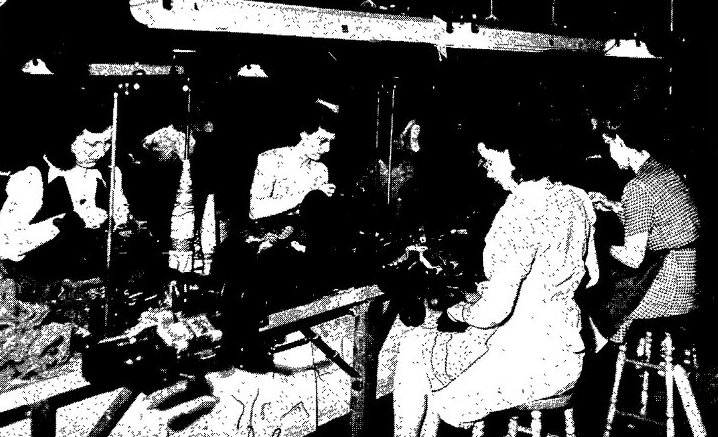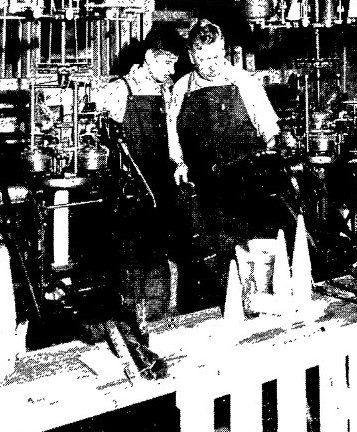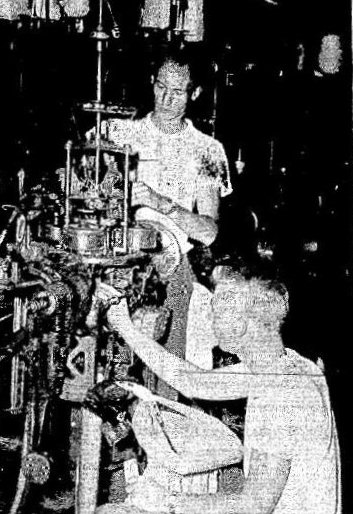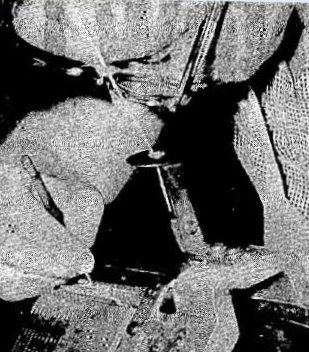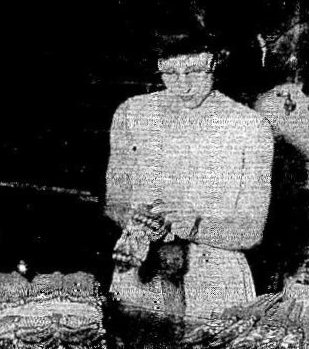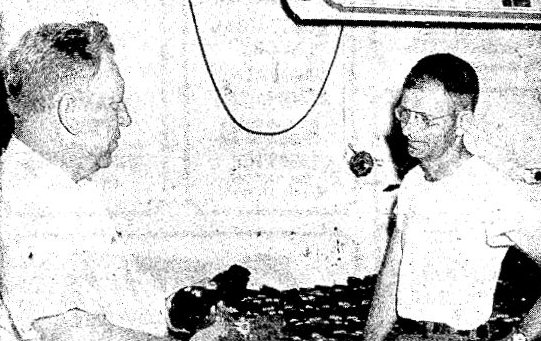|
The Waterloo Sunday Courier, Waterloo, Iowa, May 12, 1946, Page 6 Marr Knitting Mill Is New Industry for Osage
By Rena Jean Tesch
Osage, Iowa — The "three little kittens who lost their mittens" would have a glorious time at Marr Knitting, Inc., for there are not only dozens and hundreds of dozens of mittens, but many are clever little Mickey Mouse designs. The mill, in operation in Osage for just two months, hopes to go on full time production within a few days, and has begun a 50-hour week. The last week 100 pairs of mittens were turned out daily. That should be increased to 150 dozen pairs this week and continue throughout the summer. A trip through the mill is most interesting. The brick building is scrupulously clean and well lighted. Thirty-three girls are at work in the various departments, working at top speed. Francis Marr is president, and Urban Marr, vice president. The two men working for the company are both ex-service men, Robert Doudna, discharged as a corporal, after duty in India, and Jake Grimm, gunner’s mate, U.S. navy. The vice president, elder of the two owners, has had 22 years experience in knitting mills in Wisconsin.
Circular Department. The first department is the circular, where five machines costing nearly $6,000, are being operated. There are two ladies’ machines, and a children’s. Each machine turns out about 24 dozen pairs of mittens in a day, and all is automatic. Each is driven from a straight drive shaft, and the patterns in various colors woven into the mittens, in a tubular mitten blank, and all are connected. Yards and yards of mittens without fingers or thumbs, are here made, in a long roll. The next department is the cutting, where the mitten blanks are separated. The third step is to the fingering department, where the stitches are picked up, threaded for the fingers or thumbs, and then the process is automatically completed. Expert in this department is Berdine Fink Lockwood, who turns out 23 dozen pairs of mittens in eight hours. This is strenuous for the eyes and requires exactness. The next department is called the tipping department. Here the tips of fingers are closed either by machine, or by hand. Hand done ones are a bit more expensive. Next the glove or mittens goes to the brushing department, were it is turned and napped. There again the difference in gloves is determined. Some are brushed, some not, depending upon the price one is to pay for the glove or mitten. Shaping Comes Next. The shaping of the product is next in line, which is done on a wooden form like a paddle, and it is then placed in a sterilizer type steam bath. Here it is subjected to high pressure, assuring one of the correct shape. In the finishing department, all ends are pulled, mittens mated, and ticketed. Any made in a product are here discovered and inferior product immediately returned for readjustment. In the packing department, paradichloric benzine is used—like moth crystals, assuring the dealer 100 per cent all woolen mittens or gloves will be ready for market, when the cold weather comes, and will be in perfect condition. Some gloves are of virgin wool, remainder or 100 percent wool. No product is made at Marr Knitting that is not 100 per cent wool. Soon the company hopes to produce some novelties, depending upon the yarn available. Five representatives are on the road selling the mittens and gloves to all points west of Chicago. The Marr brothers hope to have another machine soon, for men’s mittens. Right now it’s just the kiddies, the young misses and the women who will be kept snug and warm when old man Winter chooses again to visit.
|
|
The Mason City Globe-Gazette, Mason City, Iowa, July 12, 1957 Osage Industry July, But Things Not Too Hot By Bill Webb
OSAGE—It’s July, but things aren’t too hot in the mitten business. At least that’s the viewpoint of Urban Marr who owns and operates Marr Knitting, Inc., a small glove and mitten mill in this North Iowa community.
"It’s the Japanese," said Urban as he removed one of a neat row of four cigars from the pocket of his nylon shirt. "They’re underselling us $3 a dozen, sometimes $4 and $5 on gloves—and what's worse, their quality is just as good as ours." Urban tore the cellophane from his cigar. Require Handiwork "Gloves require a certain amount of handiwork. That’s where they have the edge on us. They can hand weave the whole glove on a frame with labor at from six to 12 cents an hour. Our help is guaranteed $1 an hour, but most get more on piecework." Mr. Marr, however, is not an unhappy man. He doesn’t seem too much shaken by the fact that 17 out of 31 U.S. glove and mitten mills in operation in 1946 have liquidated and two others have closed down. "Ours is the only one in business west of the Mississippi," he said with a rather jovial smile. Mr. Marr and his smile in a white beard and a red suit would make a good Santa Claus. He has the pleasant warmth of a mitten about him, too. Maybe that’s why he makes and sells them. Something Fascinating Marr Knitting, Inc., might never have been if Urban hadn’t been an electrician in Kohler, Wis., in 1926. He was called out to a hosiery plant at nearby Sheboygan to fix a knitting machine. It was love at first sight and he has been in the business ever since. "There’s something about knitting machines that’s fascinating—that gets in your blood," Urban said as he bit the end off his cigar. "They’re always breaking down—something different every day." Mr. Marr has two makes of machines knitting the "blanks" or bodies of his mittens and gloves. His American machines make a mock rib
The machines knit the "blanks" automatically leaving openings for attaching thumbs, fingers, too, if gloves are being made. Each machine can be set to make any length body from toddler to men’s sizes. From the circular knitting machines, the "blanks" go to the flat machines where the thumbs and fingers are knitted. It takes but a few seconds [for] the machine operator to pick up the loops in the thum[b] or finger insert and set the shuttle in motion which adds a [digit] of the desired length. Closes Ends Next is the "tipper" who closes the ends with a few quick stitches of a needle. The ends on the hand part of the mittens are sewn shut on a machine. Both gloves and mittens are brushed, fancy stitches added if desired and then they are sent to the shaper. In the shaping department, they are pulled to size over wooden forms and given a dry steam bath. Afterwards they are inspected, mated, the mates tacked together and packed. Marr Knitting, Inc., makes gloves and mittens and mitten liners for jobbers and large chain stores all over the United States. Its chain store customers include Sears Roebuck and Co., J.C. Penney Co., McLellan’s Stores Co., W.T. Grant and J.J. Newberry Co. Some of the jobbers are Franklin TruFit Co., Chicago; Lindfelt Glove, Des Moines, Sidley [Hosiery], Minneapolis, and Miller Hat Co., St. Paul. Hand in Business "Once you get your hand in this business, you can’t get out," Urban said. He smiled, lit his cigar and paused to emit a few gentle puffs of smoke. "Take Bob Doudna," he said with a gesture in the direction of his plant superintendent. "He was my first employe[e]. He has been with me since I started here in 1946." Bob nodded. "Bob also makes up the designs for the fancy mittens," Urban added. Mr. Marr worked in Sheboygan until 1932 when he moved to Appleton, Wis., and another mill. He had two reasons for choosing Osage as the town in which to start out on his own. First, New Haven, his home town where his father still lives, is just eight miles to the east. Secondly, he believes in the superiority of small town laborers. Better Workers "They’re better workers in every way," he pointed out with a wave of his cigar. "We’ve got 50 people working here now. Last year
Woolen glove and mitten production in the United States totaled less than 1,000,000 dozen in 1956. Domestic output in 1946 was over 2,000,000 dozen. "We’re in kind of the same situation as the three little kittens who lost their mittens," Urban said. "We had 95 employe[e]s here in 1950 and ’51. That’s when all the mills had Army contracts for the Korean conflict—and that’s where the trouble started. "The domestic industry was so busy filling Army contracts that it wasn’t meeting home demand. Imports consequently, increased from about 50,000 dozen in 1946 to in excess of 2,000,000 last year. Today 95 per cent of the gloves and mittens coming into this country are from Japan." Learned Lesson Mr. Marr thinks that the industry has learned its lesson, but maybe too late. Its oriental competitors are getting more of the market each year. "If this keeps up for another 10 years, we’ll all be out of business," Urban said. Mr. Marr said the industry has been trying to get Congress to set a quota on imports. "So far we haven’t had much success," Urban said. "We’re a small industry — domestic consumption last year totaled $25,000,000. So you see we don’t get much attention.
"I guess there’s nothing to do but wait and hope for relief. We pick up a bit when another one of us goes out of business. And some chain stores and jobbers, realizing the importance of maintaining our home industry, still buy from us. Otherwise it’s pretty tough." Mr. Marr took another puff of his cigar. And it looks as though he’ll go on puffing and waiting and hoping. It’s about all he can do, that is, except tend to his knitting.
|
Transcribed by Barbara Nagy, 1-1-11
HTMLization by Kermit Kittleson, 1-2-11
